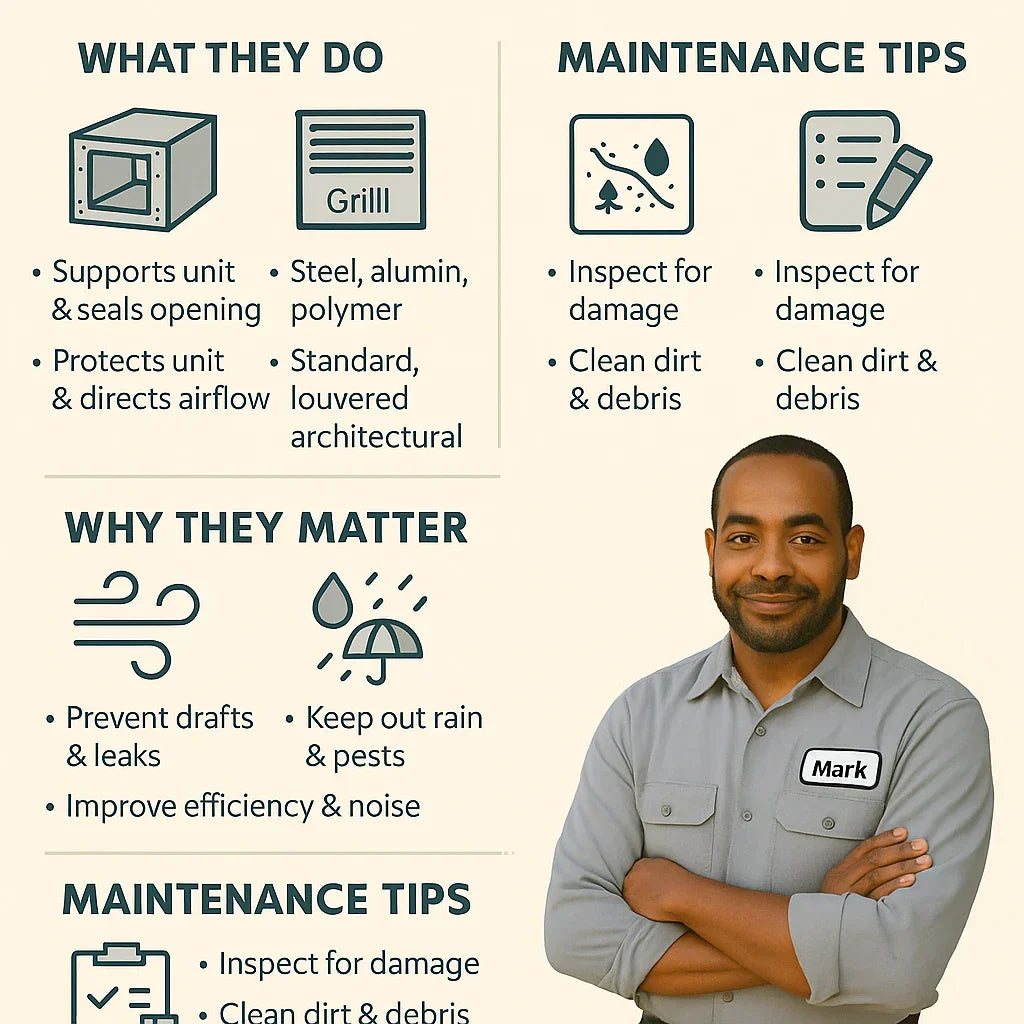By Mark — Your HVAC Guy Who Notices the Details
If you’ve ever stayed in a hotel and heard the soft hum of a unit under the window, you’ve met the PTAC (Packaged Terminal Air Conditioner). These systems, along with other through-the-wall units, are built to last—but only if the wall sleeve and grille are doing their jobs.
Homeowners often overlook these two parts, but they’re just as important as the unit itself. Without them, your AC could leak air, let in rain, and even attract pests. I’ve seen more than one homeowner blame the “AC unit” for poor performance when the real problem was a cracked sleeve or a rusted grille.
In this guide, we’ll cover:
-
What wall sleeves and grilles do
-
Materials, sizes, and features
-
Installation tips
-
How they impact performance and noise
-
Maintenance and replacement advice
🧩 1. What is a Wall Sleeve?
A wall sleeve is a metal or polymer “box” installed into an opening in your wall. The through-the-wall AC or PTAC unit slides into it.
Think of it as the structural frame and weather shield for your unit.
Functions:
-
Supports the weight of the AC unit
-
Creates a seal to prevent drafts, water leaks, and pests
-
Protects the wall opening from weather damage
-
Provides a mounting point for the outdoor grille
Mark’s Note: In hotel retrofits, I’ve pulled out wall sleeves from the 1980s that were still structurally sound—because they were installed right and made from quality materials.
🌬 2. What is a Grille?
A grille covers the outdoor-facing end of the wall sleeve.
Its job is to let air flow in and out while keeping debris, birds, and rain out.
Functions:
-
Directs airflow for efficiency
-
Protects the unit from debris
-
Adds curb appeal (especially with architectural grille styles)
🏗 3. Materials and Coatings
Wall Sleeves:
-
Galvanized steel — Strong, durable, often coated to resist corrosion
-
Aluminum — Lightweight, corrosion-resistant, but less impact-resistant
-
High-impact polymer — Won’t rust, lighter to install, but can warp in extreme heat
Grilles:
-
Powder-coated aluminum — Rust-resistant, wide color choice
-
Galvanized steel — Sturdy, but must be coated for weather protection
-
Plastic/composite — Lightweight, affordable, but less durable in harsh climates
Coatings matter: In coastal or humid regions, corrosion-resistant coatings can double or triple lifespan.
📏 4. Sizes and Compatibility
Wall sleeves and grilles must match both each other and your AC unit.
Most PTACs follow standard dimensions, such as 42" width for many U.S. models.
Mark’s Tip: Always check manufacturer specs before buying. A grille that doesn’t match your sleeve’s bolt pattern will either rattle or restrict airflow.
⚙️ 5. Installation Considerations
Wall Sleeves:
-
Must be level and pitched slightly downward toward the outside for drainage
-
Proper flashing and sealing around sleeve edges prevent leaks
-
Insulation inside the sleeve can improve efficiency
Grilles:
-
Align for proper airflow direction
-
Ensure secure attachment to prevent rattles in wind
-
Leave clearance from obstructions like shrubs or walls
📉 6. How They Affect Performance
A damaged sleeve or poorly fitting grille can:
-
Allow air leakage, reducing efficiency
-
Let rainwater into the wall cavity
-
Cause the unit to overwork, leading to early failure
-
Increase noise inside the room
Real-world example: I replaced a rusted grille that was partially blocked with paint overspray—cooling performance improved 15% after airflow was restored.
🎨 7. Aesthetics: Architectural Grilles
Architectural grilles are designed to blend with a building’s exterior.
Available in multiple colors and patterns, they’re common in condos, hotels, and upscale apartments.
🧽 8. Maintenance Tips
Every 6–12 months:
-
Inspect for rust, cracks, or loose hardware
-
Wash grille to remove dust, pollen, or salt deposits
-
Check sealant around the sleeve
-
Make sure drainage path is clear
Annual deep clean: Remove grille and vacuum inside sleeve to clear debris.
🛠 9. When to Replace
Replace if you see:
-
Rust-through holes in metal sleeves or grilles
-
Warped or cracked polymer sleeves
-
Bent grille fins restricting airflow
-
Persistent leaks despite resealing
Cost range:
-
Sleeves: $80–$250 depending on material
-
Grilles: $40–$150 depending on style
📌 10. Mark’s Inspection Checklist
-
✅ Sleeve pitched correctly for drainage
-
✅ Sealant intact and no daylight showing around sleeve edges
-
✅ Grille secured tightly—no rattles
-
✅ No obstructions to airflow
-
✅ Coating intact, no active rust
🏁 11. Key Takeaways
-
Wall sleeves and grilles are critical for weather protection, efficiency, and noise control
-
Materials and coatings matter, especially in harsh climates
-
Proper installation and sealing prevent leaks and drafts
-
Annual inspection extends life and avoids costly repairs
References
In the next topic we will read more about: Electrical Accessories: Disconnect Boxes, Whips & Breakers







